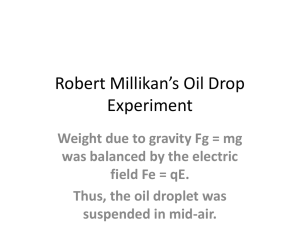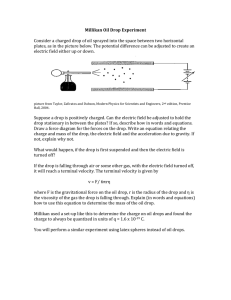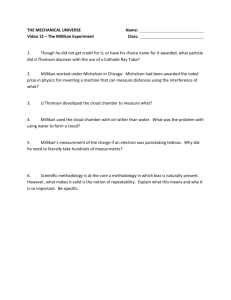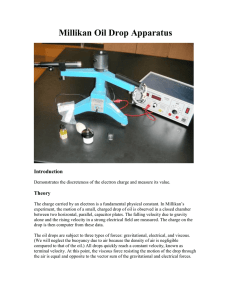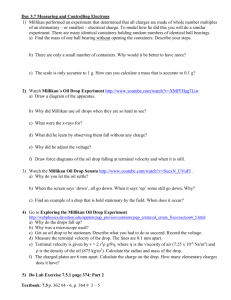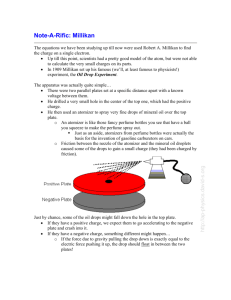Lesson 38: Millikan`s Oil Drop Experiment
advertisement
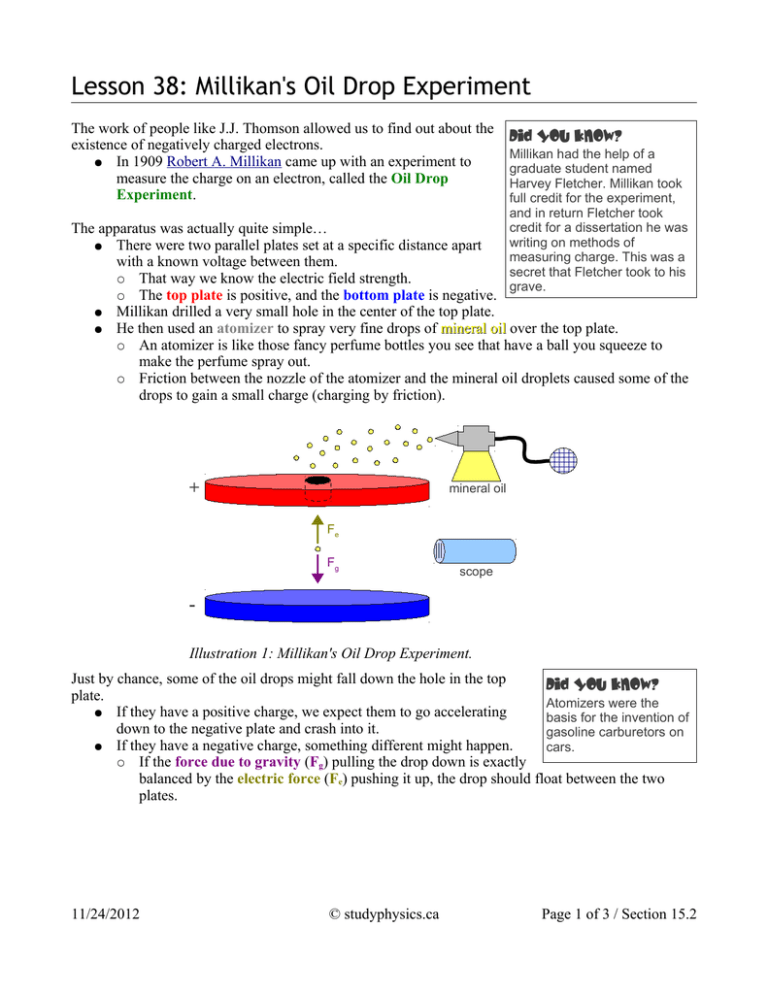
Lesson 38: Millikan's Oil Drop Experiment The work of people like J.J. Thomson allowed us to find out about the existence of negatively charged electrons. ● In 1909 Robert A. Millikan came up with an experiment to measure the charge on an electron, called the Oil Drop Experiment. Did You Know? Millikan had the help of a graduate student named Harvey Fletcher. Millikan took full credit for the experiment, and in return Fletcher took credit for a dissertation he was writing on methods of measuring charge. This was a secret that Fletcher took to his grave. The apparatus was actually quite simple… ● There were two parallel plates set at a specific distance apart with a known voltage between them. ○ That way we know the electric field strength. ○ The top plate is positive, and the bottom plate is negative. ● Millikan drilled a very small hole in the center of the top plate. ● He then used an atomizer to spray very fine drops of mineral oil over the top plate. ○ An atomizer is like those fancy perfume bottles you see that have a ball you squeeze to make the perfume spray out. ○ Friction between the nozzle of the atomizer and the mineral oil droplets caused some of the drops to gain a small charge (charging by friction). + mineral oil Fe Fg scope Illustration 1: Millikan's Oil Drop Experiment. Just by chance, some of the oil drops might fall down the hole in the top Did You Know? plate. Atomizers were the ● If they have a positive charge, we expect them to go accelerating basis for the invention of down to the negative plate and crash into it. gasoline carburetors on ● If they have a negative charge, something different might happen. cars. ○ If the force due to gravity (Fg) pulling the drop down is exactly balanced by the electric force (Fe) pushing it up, the drop should float between the two plates. 11/24/2012 © studyphysics.ca Page 1 of 3 / Section 15.2 Since the force due to the electric field and the force due to gravity are balanced, it is possible to derive an equation to calculate the charge on the droplet. F e =F g q E =mg V q =mg d mgd q= V q = charge (C) m = mass of oil droplet (kg) g = acceleration due to gravity (m/s2) d = distance between plates (m) V = voltage (V) Measuring the mass of the oil droplet is a bit of a tough one, especially since it usually only floated for a couple of seconds and then splattered on one of plates. ● Millikan had a solution to this problem… ○ First, he used a miniature telescope with hash lines etched onto the glass. When he looked into the scope he’d see something like Illustration 2. ■ By knowing the distance between the hash marks, Millikan could measure the diameter of the oil drops. Then he could figure out the Illustration 2: Hash volume of the oil drop. lines are scratched ■ Then he would use the density of mineral oil to find the mass of the into the lens. oil drop. Millikan spent thousands of hours squinting through that scope, Did You Know? desperately trying to see drops float and quickly measure their As of 1986 the most precise and diameter. accurate measurement of the ● After thousands of trials, Millikan had enough successful elementary charge is trials to show that all of the charges he calculated were 1.60217653(14)e-19 C. The last multiples of one number, 1.60e-19 C. two numbers are in brackets ○ Since he never found a smaller common multiple of this because although they are charge, he concluded this must be the charge on a single considered “questionable”, they might still be applied in some electron. calculations. ● Because it is the most basic charge possible we call it an elementary charge , “e” on data sheets. ● The idea that charge could be quantized (broken down to an indivisible piece) had been proven. ○ This is sometimes called the quantization of charge. ● Since we now have both the charge-to-mass ratio (q/m) and the charge of an electron, we can also work out the mass of an electron, 9.11e-31 kg. 11/24/2012 © studyphysics.ca Page 2 of 3 / Section 15.2 Example 1: An oil drop in a Millikan apparatus is determined to have a mass of 3.3e-15 kg. It is observed to float between two parallel plates separated by a distance of 0.95cm with 340V of potential difference between them. Determine how many excess (extra) electrons are on the drop. F e =F g mgd q= V 3.3e-15(9.81)(0.0095) q= 340 q=9.04539706e-19=9.0e-19C But the question asked how many excess electrons are on the drop, not for the charge. Since we know one electron has a charge of 1.60e-19 C… 9.04539706e-19 C =5.65337316 electrons 1.60e-19 C /electron Since it is impossible to have part of an electron, we round this off to get the final answer of six excess electrons. Homework p763 #1, 2 p764 #1 11/24/2012 © studyphysics.ca Page 3 of 3 / Section 15.2
